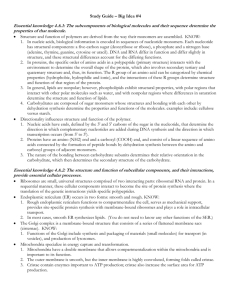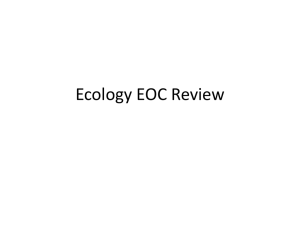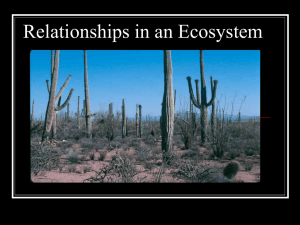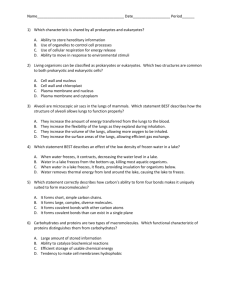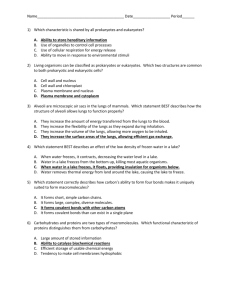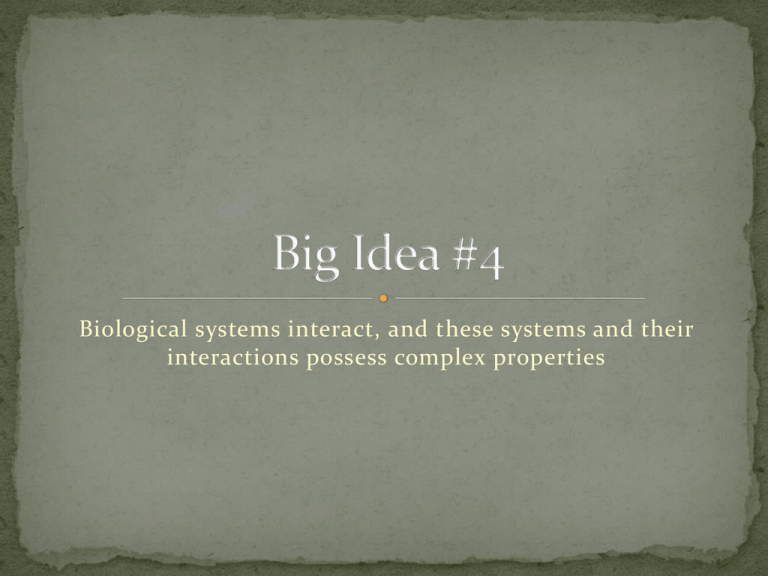
Biological systems interact, and these systems and their
interactions possess complex properties
Nucleic acids (DNA and RNA)
Nucleotides: 5-C sugar (deoxyribose, ribose), phosphate,
nitrogen base (adenine, guanine, cytosine, thymine, uracil)
Proteins
Amino acids joined by peptide bonds (‘polypeptides’)
Lipids
Fatty acids
Carbohydrates
Sugar monomers
Monomers are joined into polymers via dehydration
synthesis reactions in which a water molecule (H+ and
OH-) is removed
DNA and RNA differ in their function and differ
slightly in structure, and these structural differences
account for differing functions
Nucleic acids have ends, defined by the 3’ and 5’
carbons of the sugar in the nucleotide, that determine
the direction in which complementary nucleotides are
added during DNA synthesis and the direction in
which transcription occurs (from 5’ to 3’)
Primary structure:
Amino acid sequence
Secondary structure:
Coiling or pleating
Tertiary and quaternary structure
Folding, doubling, globbing
The specific R group of an amino acid can be categorized
by chemical properties (hydrophobic, hydrophilic, ionic)
Interactions here can determine structure and function of
that region of the protein
Proteins have an amino (NH2) end and a carboxyl (COOH)
end
Phospholipids have polar regions that interact with
other polar molecules such as water
The nature of the bonding between carbohydrate
subunits determines their relative orientation in the
carbohydrate, which then determines the secondary
structure of the carbohydrate
Ribosomes are small, universal structures comprised
of two interacting parts: ribosomal RNA and protein.
In a sequential manner, these cellular components
interact to become the site of protein synthesis where
the translation of genetic instructions yields specific
polypeptides
Endoplasmic reticulum occurs in two forms:
Rough ER functions to compartmentalize the cell, serves
as mechanical support, provides site-specific protein
synthesis with membrane-bound ribosomes and plays a
role in intracellular transport
In most cases, smooth ER synthesizes lipids
The Golgi complex is a membrane-bound structure that
consists of a series of flattened membrane sacs (cisternae)
Functions of the Golgi include synthesis and packaging of
materials (small molecules) for transport (in vesicles) and
production of lysosomes
Mitochondria specialize in energy capture and
transformation
They have a double membrane that allows
compartmentalization within the mitochondria and is
important to its function
The outer membrane is smooth, but the inner membrane has
folds called cristae
Cristae increase the surface area and contain enzymes
important to ATP production
Lysosomes are membrane-enclosed sacs that contain
hydrolytic enzymes which are important in
intracellular digestion, the recycling of a cell’s organic
materials and programmed cell death (apoptosis)
A vacuole is a membrane-bound sac that play roles in
intracellular digestion and the release of cellular waste
products. In plants, a large vacuole serves many
functions, from storage of pigments or secondary
compounds and water to provide turgor pressure
Chloroplasts are specialized organelles found in algae and higher
plants that capture energy through photosynthesis
The structure and function relationship in the chloroplast allows
cells to capture the energy available in sunlight and convert it to
chemical bond energy via photosynthesis
Chloroplasts contain pigments, which are responsible for the color
of a plant and are the key light-trapping molecules in
photosynthesis. There are several types of light-trapping pigments,
but the predominant form in plants is chlorophyll a
Chloroplasts have a double outer membrane that creates a
compartmentalized structure, which supports its function. Within
the chloroplasts are membrane-bound structures called thylakoids.
Energy-capturing reactions housed in the thylakoids are organized
in stacks, called grana, to produce ATP and NADPH2, which fuel
carbon-fixing reactions in the Calvin-Benson cycle. Carbon fixation
occurs in the stroma, where molecules of CO2 are converted to
carbohydrates
Differentiation in development is due to external and
internal cues that trigger gene regulation by proteins
that bind to DNA
Structural and functional divergence of cells in
development is due to expression of genes specific to a
particular tissue or organ type
Environmental stimuli can affect gene expression in a
mature cell
Interactions and coordination between organs provide
essential biological activities
Stomach and small intestines
Kidney and bladder
Root, stem, and leaf
Interactions and coordination between systems
provide biological activities
Respiratory and circulatory
Nervous and muscular
Plant vascular and leaf
The structure of a community is measured and described in terms of species
composition and species diversity
Mathematical or computer models are used to illustrate and investigate
population interactions and environmental impacts on a community
Predator/prey relationships
Symbiotic relationships
Introduction of species
Global climate change models
Mathematical models and graphical representations are used to illustrate
population growth patterns and interactions
Reproduction without constraints results in the exponential growth of a
population
A population can produce a density of individuals that exceeds the system’s
resource availability
As limits to growth due to density-dependent and density-independent factors
are imposed, a logistic growth model generally ensues
Demographics data with respect to age distributions and fecundity can be used
to study human populations
Energy flows, but matter is recycled
Changes in regional and global climates and in atmospheric composition
influence patterns of primary productivity
Organisms within food weds and food chains interact
Food webs and food chains are dependent on primary productivity
Models allow the prediction of the impact of change in biotic and abiotic
factors
Competition for resources and other factors limits growth and can be described
by the logistic model
Competition for resourses, territoriality, health, predation, accumulation of
wastes and other factors contribute to density-dependent population regulation
Human activities impact ecosystems on local, regional and global scales
As human populations have increased, their impacts on habitats for other
species have been magnified
This has often reduced the population size of the affected species, and resulted
in habitat destruction and in some case, the extinction of a species
Many adaptations of organisms are related to obtaining and using energy and
matter in a particular environment
Change in the structure of a molecular system may result in a change of the
function of the system
The shape of enzymes, active sites and interaction with specific molecules are
essential for basic functioning of the enzyme
For an enzyme-mediated chemical reaction to occur, the substrate must be
complementary to the surface properties (shape and charge) of the active site.
Cofactors and coenzymes affect enzyme function; this interaction relates to a
structural change that alters the activity rate of the enzyme.
Other molecules and the environment in which the enzyme acts can enhance
or inhibit enzyme activity. Molecules can bind reversibly or irreversibly to the
active or allosteric sites, changing the activity of the enzyme
The change in function of an enzyme can be interpreted from data regarding
the concentrations of product or substrate as a function of time. These
representations demonstrate the relationship between an enzyme’s activity, the
disappearance of substrate, and/or presence of a competitive inhibitor
Organisms have areas or compartments that perform a subset of
functions related to energy and matter, and these pasts
contribute to the whole
At the cellular lever, the plasma membrane, cytoplasm, and in
eukaryotes, the organelles, contribute to the overall specialization
and functioning of the cell
Within multicellular organisms, specialization of organs
contributes to the overall functioning of the organism
Exchange of gases
Circulation of fluids
Digestion of food
Excretion of wastes
Interactions among cells of a population of unicellular organisms ,
and these interactions lead to increase efficiency and utilization of
energy and matter
Bacterial community in the rumen of animals
Bacterial community in and around deep sea vents
Interactions between populations affect the distributions and abundance of
populations
Competition, parasitism, predation, mutualism, and commensalism can affect
population dynamics
Relationships among interacting populations can be characterized by positive
and negative effects, and can be modeled mathematically
Many complex symbiotic relationships exist in an ecosystem, and feedback
control systems play a role in the functioning of these ecosystems
A population of organisms has properties that are different from those of the
individuals that make up the population. The cooperation and competition
between individuals contributes to these different properties
Species-specific and environmental catastrophes, geological events, the sudden
influx/depletion of abiotic resources or increased human activities affect
species distribution and abundance
Loss of keystone species
Kudzu
Dutch elm disease
Human impact accelerates change at local and global levels
Logging, slash and burn agriculture, urbanization, monocropping,
infrastructure development, and global climate change threaten
ecosystems and life on Earth
An introduced species can exploit a new niche free of predators or
competitors, thus exploiting new resources
Introduction of new diseases can devastate native species
Dutch elm disease
Potato blight
Small pox (historic example for Native Americans)
Geological and meteorological events impact ecosystem
distribution
Biogeographical studies illustrate these changes
El Nino
Continental drift
Meteor impact on dinosaurs
Variations within molecular classes provide cells and organisms
with a wider range of functions
Different types of phospholipids in cell membranes
Different types of hemoglobin
MHC proteins
Chlorophylls
Molecular diversity of antibodies in response to an antigen
Multiple copies of alleles or genes may provide new phenotypes
A heterozygote may be a more advantageous genotype than a
homozygote under particular conditions, since with two different
alleles the organism has two forms of proteins that may provide
functional resilience in response to environmental stresses
Gene duplication creates a situation in which one cope of the gene
maintains its original function, while the duplicate may evolve a
new function
The antifreeze gene in fish
Environmental factors influence many traits both directly and
indirectly
Height and weight in humans
Flower color based on soil pH
Seasonal fur color in arctic animals
Sex determination in reptiles
Density of plant hairs as a function of herbivory
Effect of adding lactose to a Lac+ bacterial culture
Effect of increased UV on melanin production in animal
Presence of the opposite mating type on pheromones production in
yeast and other fungi
An organism’s adaptation to the local environment reflects a
flexible response of its genome
Darker fur in cooler regions of the body in certain mammal species
Alterations in timing of flowering due to climate changes
Population ability to respond to changes in the environment is affected by
genetic diversity. Species and populations with little genetic diversity are at risk
for extinction
California condors
Black-footed ferrets
Prairie chickens
Potato blight causing the potato famine
Corn rust affects on agricultural crops
Tasmanian devils and infectious cancer
Genetic diversity allows individuals in a population to respond differently to
the same changes in environmental conditions
Not all animals in a population stampede
Not all individuals in a population in a disease outbreak are equally affected;
some may not show symptoms, some may have mild symptoms, or some may be
naturally immune and resistant to the disease
Allelic variation within a population can be modeled by the Hardy-Weinberg
equation
Natural and artificial ecosystems with fewer
component parts and with little diversity among the
parts are often less resilient to changes in the
environment
Keystone species, producers, and essential abiotic and
biotic factors contribute to maintaining the diversity
of an ecosystem. The effects of keystone species on the
ecosystem are disproportionate relative to their
abundance in the ecosystem, and when they are
removed from the ecosystem, the ecosystem often
collapses

